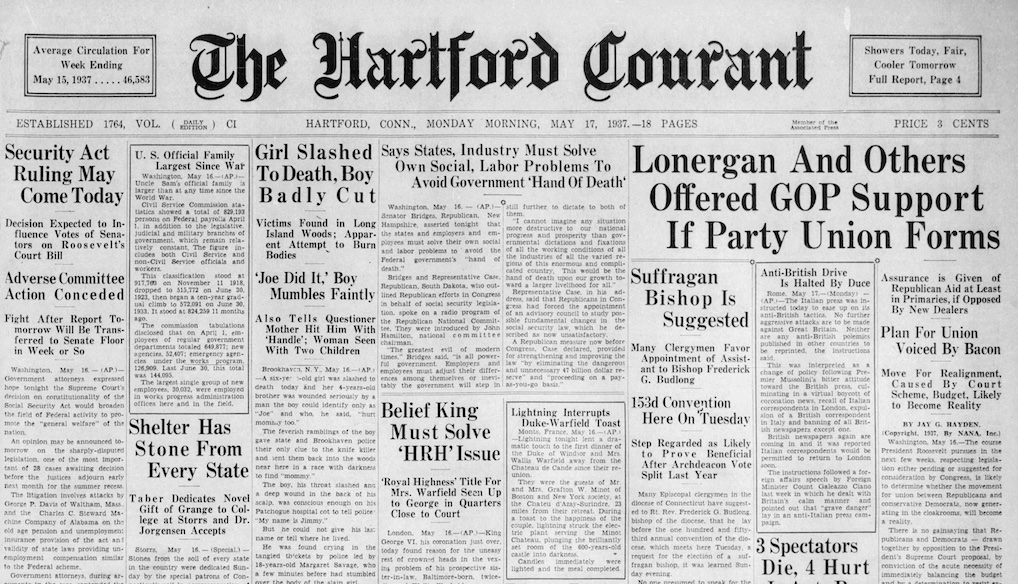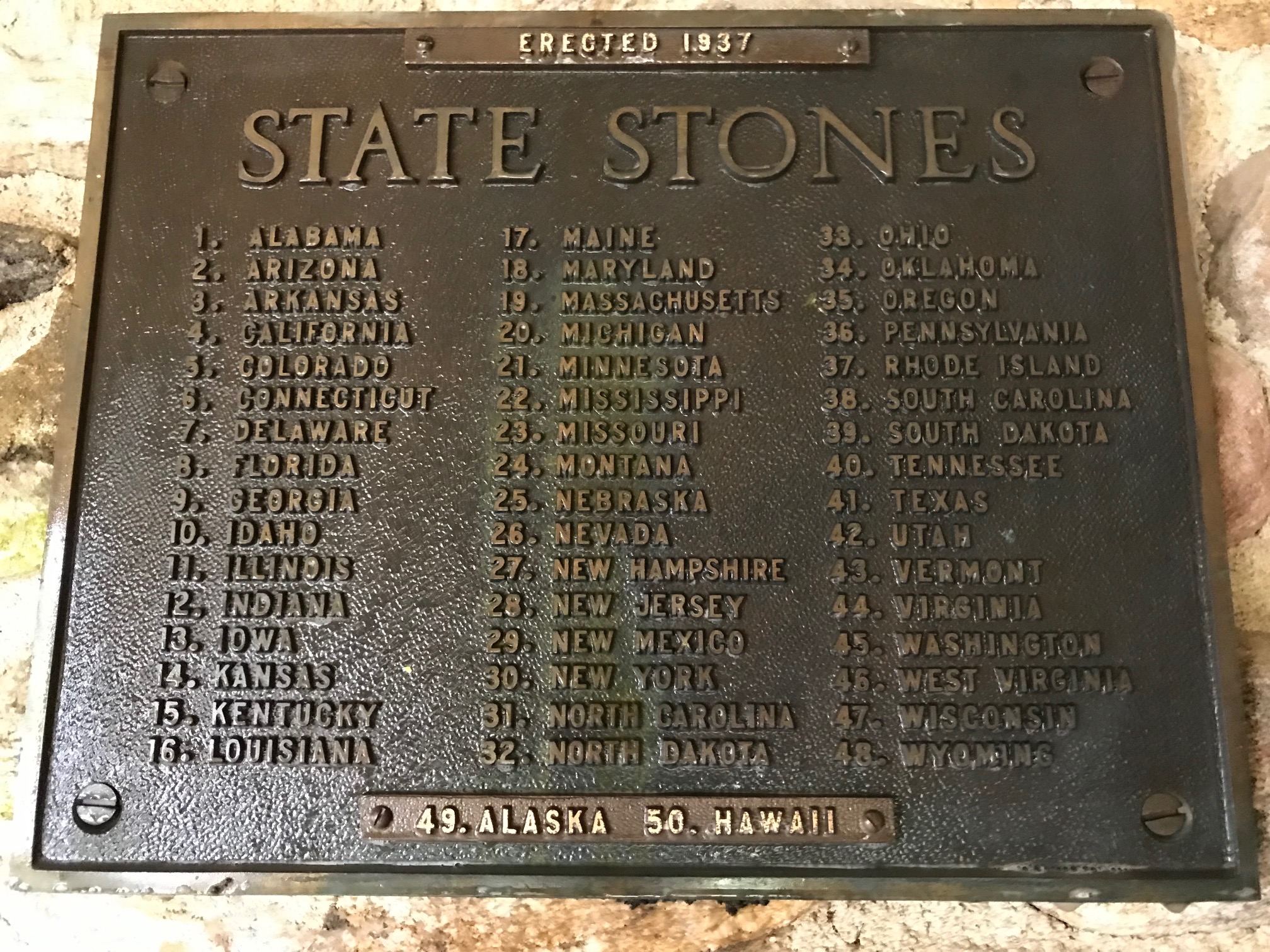The Stone Pavilion Project
Learn More – History – Dedication
A Grand Celebration
On Monday, May 17, 1937, residents across Connecticut opened their morning newspaper, the Hartford Courant, to read a front-page story about a tiny hexagonal stone building on the campus of what was then Connecticut State College. Four years earlier, in 1933, the institution had been Connecticut Agricultural School. Two years later, in 1939, it would become the University of Connecticut. This article is the first of two known source documents describing the event. The other source document is an article published on May 18 in the campus newspaper, the Connecticut Campus, which is less detailed, provides no new information, and appears to have been written with the Hartford Courant article as a source.
"Shelter Has Stone From Every State" read the headline, which referred to a small, open-air pavilion no bigger than an expedition tent that rests above a foundation of quarried flagstones and below a slate roof. The interior wall to the north --three segments of the hexagon-- contains an exhibit of beautiful specimen stones from all 48 of the nation's states at that time. To the south are three open archways that allow easy access to and from the viewing area.
Headline News

Link here to separate scans of Courant Front Page and Courant Page 2 of the May 17, 1937 Hartford Courant. A Transcript of the pavilion article is easier to read.
The front-page story about the dedication of the Stone Pavilion coincides with other stories involving the national politics of the F.D. Roosevelt administration, a very British scandal about King George VI, and local crimes and tragedies. On subsequent pages were cartoons and advertisements from the waning years of America's Great Depression. Stylish straw hats cost $3.50. Luxury apartment rentals in Hartford went for $55 per month. Sexist cartoons reveal gender stereotypes. The near-invisibility of non-European racial groups and ethnicities is troubling. Concerns were being raised over profligate spending on the Works Progress Administration. Catastrophic and record-breaking spring floods soaked a capitol city not yet protected by dikes.
On the following day of May 18, the campus newspaper for Connecticut State College, The Connecticut Campus, headlined a much shorter follow-up story titled "Grange Gives College Unique Stone Shelter." Both articles describe the pavilion being dedicated as a "tribute to agriculture" to symbolize the "interwoven" history between what is now the University of Connecticut and the state chapter of the first successful national farming organization in the United States. Founded in 1867, and officially known as the Order of Patrons of Husbandry, the grange remains today as a family- and community-based group, whose history in Connecticut is documented by Lida Skilton Ive's book, The Grange in Connecticut. (Winsted CT: Dowd Printing, 1953, p 108). Establishment of the Storrs Agricultural School in 1881 was an outgrowth of that same national movement for agricultural reform. During these early years, the Connecticut Grange, founded in 1885, was the chief political advocate for UConn's institutional growth.
Quoting the anonymous Hartford Courant reporter: "a visitor could stand" in the sweet spot of the memorial, and "with a sweep of his hand touch a very solid part of every state." This was true at the time because the protective grille had not yet been built. Today, you can see the stones, but not touch them.
The Courant article contains the only known descriptions of the stones. Examples included: "silver-bearing ore from Montana, petrified honeycomb from Iowa, [and] a piece of petrified tree from Arizona." Also included are "eight or 10 varieties of marble in many beautiful shades," and a "choice selection of granites, "pale granite from Stone Mountain Georgia ... pink granite from Texas" and a "beautiful polished slab from deep in a Vermont hill." Unusual stones include one from Maine "on which had been carved a potato bearing the carved word "Aroostook," and one "from the State of Washington's new $17,000,000 tunnel." Such descriptions suggest that the person who collected them, Albert P. Marsh, was interviewed, but this has not yet been verified. Who else would have known?

Not until we began our investigation in Fall 2022 did we realize the the article contains mistakes, perhaps drawn from some source document unknown to us, or to inaccurate reporting. For example, the stone from North Dakota, is not a "solid" part of the Earth because it was dragged south from Canada by the Laurentide Ice Sheet, perhaps from as far away as Hudson Bay. The stone from Mississippi is likely an error because there are no source rocks in the state from which it could have been derived. The fossil "honeycomb" is wrong because flowering plants and pollinating insects had not yet evolved. Instead, it's a fossil coral from a group called favosites that went extinct in the Paleozoic Era. The marbles are misidentified, because none were found. These likely refer to milky quartz from igneous and metamorphic veins. Some of the granites are granite-like, but are not granites, being monzonites and granodiorites instead.
The most accurately located stone is from Stone Mountain, Georgia because that name is carved on the stone. This is Georgia's largest and most beautiful mountain and a very popular tourist destination. In 1965 it became America's largest confederate memorial, the Mount Rushmore for the slave states. Debates are ongoing about whether the statues of President Jefferson Davis, General Robert E. Lee, and Stonewall Jackson should erased.
Ironically, the featured stone from Connecticut, the so-called Land of Steady Habits, is arguably the most complex and dynamic. It is a seismically shattered and a hydrothermally recrystallized specimen of barite ore that was collected more than 200 feet below the surface from a deep, abandoned mine shaft in Cheshire, New England's deepest and most extensive underground mine.
Presiding over the dedication ceremony on May 16, 1937. was the national grange master, Louis J. Taber of Columbus Ohio. His presence symbolized the national significance of the pavilion. In pointedly political remarks, he dedicated "yonder structure representing in a tangible form every one of the 48 states in our American Union," as an "enduring tribute to agriculture and to the tillers of the soil." Master of the State Grange, Frank H. Peet remarked that the stones were "cemented together to furnish a single building symbolic of the fact" that "cooperation spells success." Accepting the gift on behalf of the college was President Albert N. Jorgensen, "not only as a tribute to Connecticut agriculture but to Connecticut Youth." Quoting the Courant article directly: "The college president then said that the stone structure has not been completed but eventually will have a bench, a bronze protective grill to save the collected stones incorporated in one wall, and two bronze tablets, one noting the positions of the stones from the various states, and the other stating the fact that the building is a tribute to Connecticut agriculture."
The bench was built, but is now rotting away. A grill was mounted, though it was made of iron that rusts and from which paint flakes. The second bronze tablet describing the pavilion's purpose was likely center mounted on the northern segment of the exhibit wall because there's a prominent gap between the specimen stones of rows 3 and 4. And in that gap are drilled holes defining a square identical in size the remaining plaque. The absence of this signage helps explain why the pavilion is so little known. Visitors would not know what it was or why it was there.

Prior to the dedication, an estimated 3,000 grangers, collegians, and politicians had assembled for a Sunday morning church service in the nearby Storrs Congregational Church and on its lawn. This was followed by a picnic luncheon, with background music provided by esteemed botany Professor G. Safford Torrey on the church bells (carillon) and a concert by the Grange Band from Plymouth, CT. After the dedication ceremony, the music continued with "songs by the Grange Chorus," vocal and instrumental solos, a violin obligato, and accordion music, all broadcast by radio across campus.
The final paragraph of the article describes the Connecticut specimen stone as "one of the most beautiful stones, showing many beautiful colors in a single block less than a foot square.... was taken from a pit 200 feet below the surface, nearly beneath the Cheshire Reformatory where many decades ago there was a barite mine." This is all true, except for the word "pit," which likely refers to a mine shaft.
At the time, Alaska and Hawaii were still territories. Their stones were added later, and include: a quartz vein from Alaska with what appears to be a glint of gold, and a recently-cooled lava flow from an active volcano in Hawaii.
The end result was a permanent outdoor exhibit of specimen stones that was variously called a stone: structure, building, monument, memorial, shelter, and pavilion by the reporters, editors, and photographers associated with the dedication. Of these, the name "stone pavilion" is the best one going forward because this is the word the gift-giving grange used. The term shelter was used by the anonymous reporters.
Learn More about the Grange